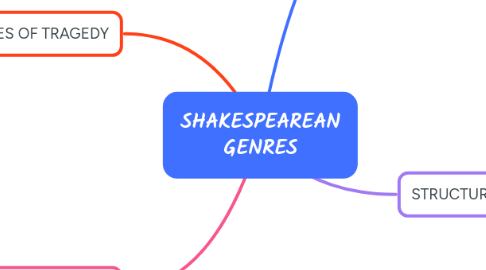
1. TYPES OF TRAGEDY
1.1. Jacobean/Revenge Tragedy
1.1.1. Jacobean Tragedy, written during King James I's reign (1603-1625), was influenced by Senecan Tragedy, with revenge being a dominant motivation for characters. The sub-genre features blood, brutality, and chaos, with the revenger feeling it is their duty to seek revenge for a wrong.
1.2. Political Tragedy
1.2.1. Apolitical tragedies focus on political power and state affairs, taking place in public areas, but the personal tragedies that occur overshadow the political situation. The main plot explores social order/disorder.
1.3. Domestic Tragedy
1.3.1. Domestic tragedies feature relatable, middle or lower class protagonists and explore personal themes in a private, domestic setting, delving into the workings of the human mind rather than political issues.
2. CHARACTERS IN TRAGEDY
2.1. The tragic hero
2.1.1. Aristotle believed tragic heroes should have a fatal flaw, making their downfall inevitable. They can provoke both positive and negative responses from the audience, and may suffer madness.
2.2. The villain
2.2.1. Tragic villains cause chaos in tragic texts, manipulate the hero, and may have understandable motivations or be depicted as inherently evil. They can be cynical, quick-witted, and a source of irony and humor. They may be both monstrous and admirable, but usually die for catharsis and to restore order.
3. INTRODUCCION
3.1. Definition of tradegy
3.1.1. Tragedy is a genre depicting human suffering, ending in disaster and death. Shakespearean tragedy allowed for societal reflection, while exploring destructive impulses and human experiences.
4. STRUCTURE OF TRAGEDY
4.1. Exposition
4.1.1. The audience learns about the setting (time and place) and the characters are developed
4.2. Complication
4.2.1. An incident or issue begins a conflict that will continue throughout the play.
4.3. Rising Action
4.3.1. The action in this stage leads to the climax. Complications may arise, or the protagonist may encounter obstacles.
4.4. Climax
4.4.1. Turning point of the play where the hero moves towards their end.
4.5. Falling Action
4.5.1. Events after climax up to hero's death, showing advances and declines in forces acting upon them.
4.6. Catastrophe
4.6.1. Necessary consequences of hero's actions, typically resulting in their death.
4.7. Denouement or Resolution
4.7.1. Necessary consequences of hero's actions, typically resulting in their death.
